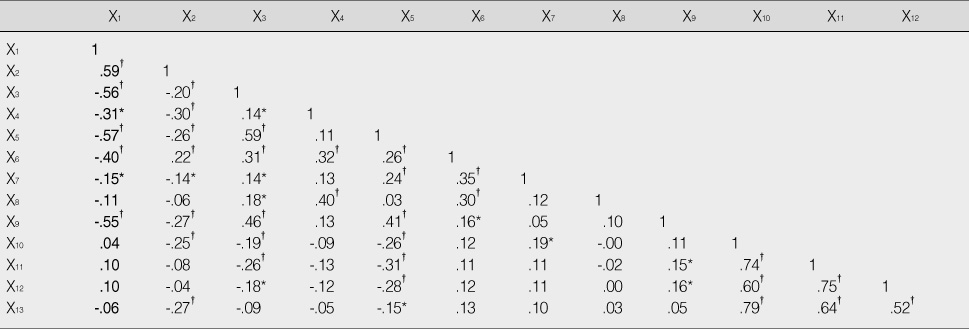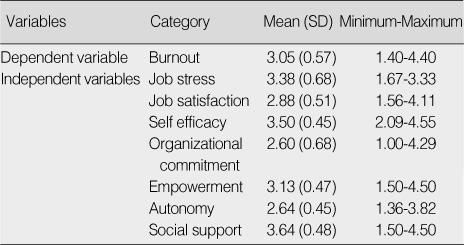Articles
- Page Path
- HOME > J Korean Acad Nurs > Volume 40(6); 2010 > Article
-
Original Article
- Contingent Nurses' Burnout and Influencing Factors
- Won Ock Kim, Sook Ja Moon, Sang Sook Han
-
Journal of Korean Academy of Nursing 2010;40(6):882-891.
DOI: https://doi.org/10.4040/jkan.2010.40.6.882
Published online: December 31, 2010
1Professor, College of Nursing Science, East-West Nursing Research Institute, Kyung Hee University, Seoul, Korea.
2Doctoral Students, College of Nursing Science, Kyung Hee University, Seoul, Korea.
- Address reprint requests to: Han, Sang Sook. College of Nursing Science, East-West Nursing Research Institute, Kyung Hee University, 1 Hoegi-dong, Dongdaemun-gu, Seoul 130-701, Korea. Tel: 82-2-961-9427, Fax: 82-2-961-9398, sshan12@khu.ac.kr
Copyright © 2010 Korean Society of Nursing Science
Abstract
-
Purpose
- This study was designed to identify burnout and factors influencing burnout in contingent nurses.
-
Methods
- A cross-sectional design was conducted with a sample of 228 contingent nurses randomly selected from 25 general hospitals in Korea. The tools used for this study were scales measuring burnout (8 items), job stress (8 items), job satisfaction (9 items), self efficacy (9 items), organizational commitment (9 items), empowerment (9 items), autonomy (7 items) and social support (8 items). The data were analyzed using SPSS 15.0 employing Pearson correlation coefficients and multiple regression analysis.
-
Results
- The mean score for burnout in contingent nurses was 3.05 points. Factors influencing burnout in contingent nurses were identified as job stress (β=.40), satisfaction level with current ward (β=-.25), organizational commitment (β=-.21), job satisfaction (β=-.19) and empowerment (β=-.16). These factors explained 65.0% of burnout reported by contingent nurses.
-
Conclusion
- The results indicate which factors are major factors influencing burnout in contingent nurses in general hospitals. Therefore, these factors may serve as predictors of burnout in contingent nurses.
- 1. Bandura A. Self-efficacy: Toward a unifying theory of behavioral change. Psychological Review. 1977;84:191–215.ArticlePubMed
- 2. Chi SA, Yoo HS. Concept analysis of professional nurse autonomy. Journal of Korean Academy of Nursing. 2001;31:781–792.ArticlePDF
- 3. Choi KJ. The factors that affect burnout of nurses. 2007;Seoul, Kyunghee University. Unpublished master's thesis.
- 4. Choi WH. A labor minister in non-regular employees use period four years. 2009;01 04 The Hankyoreh. 1.
- 5. Demerouti E, Bakker AB, Vardakou I, Kantas A. The convergent validity of two burnout instruments: A multitrait-multimethod analysis. European Journal of Psychological Assessment. 2003;19:12–23.Article
- 6. Han SS, Moon SJ, Yun EK. Empowerment, job satisfaction, and organizational commitment: Comparison of permanent and temporary nurses in Korea. Appl Nurs Res. 2009;22:e15–e20.ArticlePubMed
- 7. Han SS, Park SW. Prediction factors on the organizational commitment in registered nurses. Journal of East-West Nursing Research. 2006;12:5–13.
- 8. Jung SK. Hospital temporary worker issues: Low income, ease of lay off. The daily medi. 2008;12 03 Retrieved June 6, 2010. from http://www.dailymedi.com/news/opdb/index.php.
- 9. Kanter RM. Men and women of the corporation. 1977;New York, Basic Books.
- 10. Kim HK, Ji HS, Ryu EK, Lee HJ, Yun SE, Jeon MK. Factors influencing on burnout of the nurses in hospitals. Clinical Nursing Research. 2004;10(2):7–18.
- 11. Kim IW. A structural equation model on head nurse's leadership. 2005;Seoul, Kyunghee University. Unpublished doctoral dissertation.
- 12. Kim JW. The Effect of job characteristics and employment relationships characteristics on organizational commitment of contingent workers: Focused on moderating effect of job satisfaction. Journal of Human Resource Management Research. 2007;14:23–35.
- 13. Kim MS, Park YB. The effects of self-efficacy and empowerment on perceived organizational support and organizational citizenship behaviors of urses. Journal of Korean Academy of Nursing Administration. 2008;14:268–277.
- 14. Kim MY. A study on the relationship between job strain and burnout. 2004;Cheongju, Chungbuk National University. Unpublished master's thesis.
- 15. Kim TH, Kim JW, Kwon JS. The differences in predictors of job involvement between permanent and non-regular workers. Daehan Journal of Business. 2004;43:507–527.
- 16. Kim YO. A study of factors predicting burnout in hospital staff nurses. Journal of Korean Academy of Adult Nursing. 2002;14:591–601.
- 17. Ko JW, Yom YH. The role of social support in the relationship between job stress and job satisfaction/organizational commitment among hospital nurses. Journal of Korean Academy of Nursing. 2003;33:265–274.ArticlePubMedPDF
- 18. Koh SB, Son M, Kong JO, Lee CG, Chang SJ, Cha BS. Job characteristics and psychosocial distress of atypical workers. Korean Journal of Occupational and Environmental Medicine. 2004;16:103–113.ArticlePDF
- 19. Mowday RT, Steers RM, Porter LW. The management of organizational commitment. Journal of Vocational Behavior. 1979;14:224–247.Article
- 20. Park CS. Factors influencing on burnout experience in working nurses at hospital. Korean Journal of Women Health Nursing. 2002;8:550–558.ArticlePDF
- 21. Park DJ. Effectiveness of 'part time nurses' from Ministry of Health and Welfare. The daily medi. 2009;07 28 Retrieved July 3, 2010. from http://www.dailymedi.com/news/opdb/index.php.
- 22. Parker DF, DeCotiis TA. Organizational determinants of job stress. Organizational Behavior and Human Performance. 1983;32:160–177.Article
- 23. Peeters MC, Buunk BP, Schaufeli WB. Social interactions, stressful events and negative affect at work: A micro-analytic approach. European Journal of Social Psychology. 1995;25:391–401.Article
- 24. Sherer M, Maddux JE, Mercandante B, Prentice-Dunn S, Jacobs B, Rogers RW. The self-efficacy scale: Constructionvalidation. Psychological Reports. 1982;51:663–671.
- 25. Slavitt DB, Stamps PL, Piedmont EB, Haase AM. Nurses' satisfaction with their work situation. Nursing Research. 1978;27:114–120.PubMed
- 26. Spreitzer GM. Psychological empowerment in the workplace: Dimensions, measurement and validation. Academy of Management Journal. 1995;38:1442–1465.Article
- 27. Taskforce Team for Temporary Employees at the Office of Work Standard. Explanation of the law protecting the rights of temporary worker: Ministry of labor. 2006;09;Seoul, Author.
- 28. Wu Sl, Zhu W, Wang Z, Wang M, Lan Y. Relationship between burnout and occupational stress among nurse in China. Journal of Advanced Nursing. 2007;59:233–239.ArticlePubMed
REFERENCES

*p<.05; †p<.01.
X1=Burnout; X2=Job stress; X3=Job satisfaction; X4=Self-efficacy; X5=Organizational commitment; X6=Empowerment; X7=Autonomy; X8=Social support; X9=Satisfaction level with current ward; X10=Total length of clinic career; X11=Employment period at the current work; X12=Employment period on the current ward; X13=Age.
Figure & Data
REFERENCES
Citations

- The cultural difference between empowerment and job satisfaction among nurses: An umbrella review
Shih-Yu Chang, Shu-Zhuan Wang, Huan-Fang Lee
Applied Nursing Research.2025; 82: 151912. CrossRef - Sağlık Çalışanlarında Mesleki Tükenme: Görsel Haritalama Tekniği ile Bibliyometrik Bir Analiz
Melek Yağcı Özen, Seda Uyar
Abant Sosyal Bilimler Dergisi.2025; 25(1): 12. CrossRef - The Moderating Effects of Self-Care on the Relationships between Perceived Stress, Job Burnout and Retention Intention in Clinical Nurses
Seung-Hee Lee, Min-Ho Joo
Healthcare.2023; 11(13): 1870. CrossRef - Influences of Teamwork and Job Burnout on Patient Safety Management Activities among Operating Room Nurses
Ayoung Kim, Haein Lee
Journal of Korean Academy of Nursing Administration.2022; 28(5): 605. CrossRef - Factors Associated with Job Stress among Hospital Nurses: A Meta-Correlation Analysis
Ji-Young Lim, Geun-Myun Kim, Eun-Joo Kim
International Journal of Environmental Research and Public Health.2022; 19(10): 5792. CrossRef - A Comparative Study on the Job Stress, Burnout and Nursing Performance of Nurses in Comprehensive Nursing Care Service Wards and Nurses in General Wards
Youn Sil Kim, Jung Ae Park, Eun Koung Seo
Stress.2019; 27(1): 46. CrossRef - Divergent Associations of the Job Stress, the Job Satisfaction and Burnout Subtypes
Sunkyung Kim, Dohyun Ahn
Stress.2019; 27(1): 9. CrossRef - Syndrome du burnout chez le personnel soignant paramédical au Cameroun : impact des activités physiques et sportives et des loisirs
P.T. Moueleu Ngalagou, P.B. Assomo Ndemba, L.J. Owona Manga, Y. Bandga Ekanga, W.R. Guessogo, C.N. Ayina Ayina, S.H. Mandengue
Archives des Maladies Professionnelles et de l'Environnement.2018; 79(1): 55. CrossRef - Factors Influencing Hospital Nurses' Turnover Intention: A Cross-sectional Survey
Eun-Ja Yeun, Young-Mi Kwon, Mi-Soon Je, Jeong-Hwa An
The Journal of the Korea Contents Association.2016; 16(1): 94. CrossRef - Integrated approach to the working experience of non-regular outpatient nurse
Hye Jin Lee, Do Young Lee
Journal of the Korea Convergence Society.2016; 7(3): 111. CrossRef - Predictors of Turnover among New Nurses using Multilevel Survival Analysis
Suhee Kim, Kyongeun Lee
Journal of Korean Academy of Nursing.2016; 46(5): 733. CrossRef - Awareness of Hospital Safety Culture and Safety Activities of Workers in a Tertiary Care Hospital
Eun-Ho Ha, Kyoung-Soon Hyun, Jin-Young Cho
The Journal of Korean Academic Society of Nursing Education.2016; 22(2): 191. CrossRef - Perceptions of Medical Personnel toward Burnout using Q Methodology
Eun Ja Yeun, Young Mi Kwon, Young Mi Lee
Journal of Korean Academy of Nursing Administration.2016; 22(1): 57. CrossRef - Associated Factors in Pediatric Nurse Parent Partnership.
Miyoung Choi, Jisoo Kim
Child Health Nursing Research.2014; 20(3): 176. CrossRef - The Influence of the Job Stress, Job Satisfaction and Social Support of Clinical Nurse's Burnout
Kyung Jin Choi, Sang Sook Han
Journal of East-West Nursing Research.2013; 19(1): 55. CrossRef - Relations of Burnout, Interpersonal Relations, Professional Self-concept and Depression in Clinical Nurses
Eun Yi Yeom, Hae Ok Jeon
Journal of the Korea Academia-Industrial cooperation Society.2013; 14(6): 2869. CrossRef - Empowerment and Job Satisfaction among Clinical Nurses in South Korea: Systematic Review
Eun-Young Jeong
Journal of Korean Academy of Nursing Administration.2013; 19(5): 599. CrossRef - Factors Influencing Work-related Burnout of Nurses and Caregivers in Nursing Homes
Young-Mi Lee, Sung-Ja Kim, Kisook Kim
Journal of the Korea Academia-Industrial cooperation Society.2013; 14(4): 1755. CrossRef - Occupational Stress and Coping Styles as Factors Affecting the Burnout of Clinical Nurses
Kyoung Ja Kwon, Seung-Hee Lee
Journal of Korean Academy of Nursing Administration.2012; 18(4): 383. CrossRef - Work Stress, Turnover Intention and Burnout among Nurses in Neonatal Intensive Care Units
Mi Yu
Journal of Korean Academy of Nursing Administration.2011; 17(1): 115. CrossRef
Burnout by Demographics and General Characteristics of Participants (N=212)
*Sheffe test: Different letters mean significantly different.
Mean and Standard Deviation of Variables
Correlation among Variables
*p<.05; †p<.01.
X1=Burnout; X2=Job stress; X3=Job satisfaction; X4=Self-efficacy; X5=Organizational commitment; X6=Empowerment; X7=Autonomy; X8=Social support; X9=Satisfaction level with current ward; X10=Total length of clinic career; X11=Employment period at the current work; X12=Employment period on the current ward; X13=Age.
Factors Influencing Burnout in Contingent Nurses
Adj R2=Adjusted R2
*Sheffe test: Different letters mean significantly different.
* X1=Burnout; X2=Job stress; X3=Job satisfaction; X4=Self-efficacy; X5=Organizational commitment; X6=Empowerment; X7=Autonomy; X8=Social support; X9=Satisfaction level with current ward; X10=Total length of clinic career; X11=Employment period at the current work; X12=Employment period on the current ward; X13=Age.
Adj R2=Adjusted R2
 KSNS
KSNS
 E-SUBMISSION
E-SUBMISSION



 Cite
Cite

